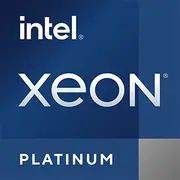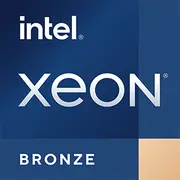Intel Xeon Platinum 8571N vs Intel Xeon Bronze 3204
Risultato del confronto CPU
Di seguito sono riportati i risultati di un confronto tra i processori
Intel Xeon Platinum 8571N
e
Intel Xeon Bronze 3204
in base alle caratteristiche prestazionali chiave, al consumo energetico e molto altro.
Vantaggi
- Più Conteggio totale dei core: 52 (52 vs 6)
- Più alto Processo di fabbricazione: 10 nm (10 nm vs 14 nm)
- Più alto Tipi di memoria: DDR5-4800 (DDR5-4800 vs DDR4-2133)
- Più nuovo Data di rilascio: December 2023 (December 2023 vs April 2019)
Di base
Intel
Nome dell'etichetta
Intel
December 2023
Data di rilascio
April 2019
Server
Piattaforma
Server
Xeon Platinum 8571N
Nome del modello
?
Il numero del processore Intel è solo uno dei numerosi fattori, insieme alla marca del processore, alle configurazioni di sistema e ai benchmark a livello di sistema, da considerare quando si sceglie il processore giusto per le proprie esigenze informatiche.
3204
Emerald Rapids
Nome in codice
Cascade Lake X
Intel
Fonderia
-
Xeon Platinum (Emerald Rapids-SP)
Generazione
-
Specifiche della CPU
52
Conteggio totale dei core
?
Core è un termine hardware che descrive il numero di unità di elaborazione centrale indipendenti in un singolo componente informatico (die o chip).
6
104
Conteggio totale dei thread
?
Ove applicabile, la tecnologia Intel® Hyper-Threading è disponibile solo sui core Performance.
6
-
Frequenza di base
1.90 GHz
-
Frequenza turbo massima
?
La frequenza Turbo massima è la frequenza single-core massima alla quale il processore è in grado di funzionare utilizzando la tecnologia Intel® Turbo Boost e, se presente, la tecnologia Intel® Turbo Boost Max 3.0 e Intel® Thermal Velocity Boost. La frequenza viene generalmente misurata in gigahertz (GHz) o miliardi di cicli al secondo.
1.90 GHz
2.4 GHz
Frequenza base del core di performance
-
4 GHz
Frequenza turbo del core di performance
?
Massima frequenza turbo P-core derivata dalla tecnologia Intel® Turbo Boost.
-
-
Intel Hyper-Threading Technology
?
Intel® Hyper-Threading Technology (Intel® HT Technology) delivers two processing threads per physical core. Highly threaded applications can get more work done in parallel, completing tasks sooner.
No
-
Intel Turbo Boost Technology
?
Intel® Turbo Boost Technology dynamically increases the processor's frequency as needed by taking advantage of thermal and power headroom to give you a burst of speed when you need it, and increased energy efficiency when you don’t.
No
-
Intel Turbo Boost Max Technology 3.0
?
Intel® Turbo Boost Max Technology 3.0 identifies the best performing core(s) on a processor and provides increased performance on those cores through increasing frequency as needed by taking advantage of power and thermal headroom.
No
80 KB per core
Cache L1
-
2 MB per core
Cache L2
-
300 MB shared
Cache L3
-
24.0
Moltiplicatore
-
100MHz
Frequenza del bus
-
Intel Socket 4677
Socket
?
Il socket è il componente che fornisce i collegamenti meccanici ed elettrici tra il processore e la scheda madre.
FCLGA3647
No
Moltiplicatore sbloccato
-
10 nm
Processo di fabbricazione
?
La litografia si riferisce alla tecnologia dei semiconduttori utilizzata per produrre un circuito integrato ed è espressa in nanometri (nm), indicativi della dimensione delle caratteristiche integrate nel semiconduttore.
14 nm
300 W
Consumo di energia
85 W
78 °C
Temperatura operativa massima
?
La temperatura di giunzione è la temperatura massima consentita sul die del processore.
-
5
Versione PCIe
?
PCI Express è uno standard di bus di espansione seriale ad alta velocità utilizzato per connettere componenti ad alta velocità, sostituendo standard più vecchi come AGP, PCI, e PCI-X. Ha subito diverse revisioni e miglioramenti dal suo rilascio iniziale. PCIe 1.0 è stato introdotto per la prima volta nel 2002, e per soddisfare la crescente domanda di maggiore larghezza di banda, sono state rilasciate versioni successive nel corso del tempo.
-
-
Versione PCI Express
?
PCI Express Revision è la versione supportata dello standard PCI Express. Peripheral Component Interconnect Express (o PCIe) è uno standard di bus di espansione per computer seriale ad alta velocità per il collegamento di dispositivi hardware a un computer. Le diverse versioni PCI Express supportano velocità dati diverse.
3.0
-
Numero di corsie PCI Express
?
Una corsia PCI Express (PCIe) è composta da due coppie di segnalazione differenziali, una per la ricezione dei dati, una per la trasmissione dei dati, ed è l'unità di base del bus PCIe. Il numero massimo di corsie PCI Express è il numero totale di corsie supportate.
48
-
Intel 64
?
Intel® 64 architecture delivers 64-bit computing on server, workstation, desktop and mobile platforms when combined with supporting software.¹ Intel 64 architecture improves performance by allowing systems to address more than 4 GB of both virtual and physical memory.
Yes
Specifiche della memoria
DDR5-4800
Tipi di memoria
?
I processori Intel® sono disponibili in quattro diversi tipi: canale singolo, doppio canale, triplo canale e modalità Flex. La velocità massima della memoria supportata potrebbe essere inferiore quando si popolano più DIMM per canale su prodotti che supportano più canali di memoria.
DDR4-2133
-
Dimensione massima della memoria
?
La dimensione massima della memoria si riferisce alla capacità di memoria massima supportata dal processore.
1 TB
8
Canali di memoria massimi
?
Il numero di canali di memoria si riferisce al funzionamento della larghezza di banda per l'applicazione del mondo reale.
6
-
Maximum Memory Speed
2133 MHz
-
ECC Memory Supported
?
ECC Memory Supported indicates processor support for Error-Correcting Code memory. ECC memory is a type of system memory that can detect and correct common kinds of internal data corruption. Note that ECC memory support requires both processor and chipset support.
Yes
Yes
Supporto memoria ECC
-
Specifiche della GPU
N/A
Grafica integrata
?
Una GPU integrata si riferisce al core grafico integrato nel processore CPU. Sfruttando le potenti capacità di calcolo del processore e la gestione intelligente dell'efficienza energetica, offre prestazioni grafiche eccezionali e un'esperienza applicativa fluida con un consumo energetico inferiore.
-
Varie
-
Intel Deep Learning Boost (Intel DL Boost) sulla CPU
?
Una nuova serie di tecnologie di processore integrate progettate per accelerare i casi d'uso del deep learning dell'intelligenza artificiale. Estende Intel AVX-512 con una nuova Vector Neural Network Instruction (VNNI) che aumenta significativamente le prestazioni di inferenza del deep learning rispetto alle generazioni precedenti.
Yes
-
Intel Virtualization Technology (VT-x)
?
Intel® Virtualization Technology (VT-x) allows one hardware platform to function as multiple “virtual” platforms. It offers improved manageability by limiting downtime and maintaining productivity by isolating computing activities into separate partitions.
Yes
-
Intel Virtualization Technology for Directed I/O (VT-d)
?
Intel® Virtualization Technology for Directed I/O (VT-d) continues from the existing support for IA-32 (VT-x) and Itanium® processor (VT-i) virtualization adding new support for I/O-device virtualization. Intel VT-d can help end users improve security and reliability of the systems and also improve performance of I/O devices in virtualized environments.
Yes
-
Intel Standard Manageability (ISM)
?
Intel® Standard Manageability is the manageability solution for Intel vPro® Essentials platforms and is a subset of Intel® AMT with out-of-band management over Ethernet and Wi-Fi, but no KVM or new life cycle management features.
Intel® SSE4.2 | Intel® AVX | Intel® AVX2 | Intel® AVX-512
-
Number of AVX-512 FMA Units
1
-
Enhanced Intel SpeedStep Technology
?
Enhanced Intel SpeedStep® Technology is an advanced means of enabling high performance while meeting the power-conservation needs of mobile systems. Conventional Intel SpeedStep® Technology switches both voltage and frequency in tandem between high and low levels in response to processor load. Enhanced Intel SpeedStep® Technology builds upon that architecture using design strategies such as Separation between Voltage and Frequency Changes, and Clock Partitioning and Recovery.
Yes
-
Execute Disable Bit
?
Execute Disable Bit is a hardware-based security feature that can reduce exposure to viruses and malicious-code attacks and prevent harmful software from executing and propagating on the server or network.
Yes
-
Cache
?
CPU Cache is an area of fast memory located on the processor. Intel® Smart Cache refers to the architecture that allows all cores to dynamically share access to the last level cache.
8.25 MB
-
Intel AES New Instructions
?
Intel® AES New Instructions (Intel® AES-NI) are a set of instructions that enable fast and secure data encryption and decryption. AES-NI are valuable for a wide range of cryptographic applications, for example: applications that perform bulk encryption/decryption, authentication, random number generation, and authenticated encryption.
Yes
-
Intel Volume Management Device (VMD)
?
Intel® Volume Management Device (VMD) provides a common, robust method of hot plug and LED management for NVMe-based solid state drives.
Yes
-
Intel VT-x with Extended Page Tables (EPT)
?
Intel® VT-x with Extended Page Tables (EPT), also known as Second Level Address Translation (SLAT), provides acceleration for memory intensive virtualized applications. Extended Page Tables in Intel® Virtualization Technology platforms reduces the memory and power overhead costs and increases battery life through hardware optimization of page table management.
Yes
80
Lane PCIe
-
Classifiche
Geekbench 6 Singolo Core
Xeon Platinum 8571N
1518
+124%
Xeon Bronze 3204
679
Geekbench 6 Multi Core
Xeon Platinum 8571N
16654
+451%
Xeon Bronze 3204
3020
Passmark CPU Singolo Core
Xeon Platinum 8571N
1969
+80%
Xeon Bronze 3204
1096
Passmark CPU Multi Core
Xeon Platinum 8571N
68385
+1314%
Xeon Bronze 3204
4835
Condividi sui social media
Oppure linkaci
<a href="https://cputronic.com/it/cpu/compare/intel-xeon-platinum-8571n-vs-intel-xeon-bronze-3204" target="_blank">Intel Xeon Platinum 8571N vs Intel Xeon Bronze 3204</a>


